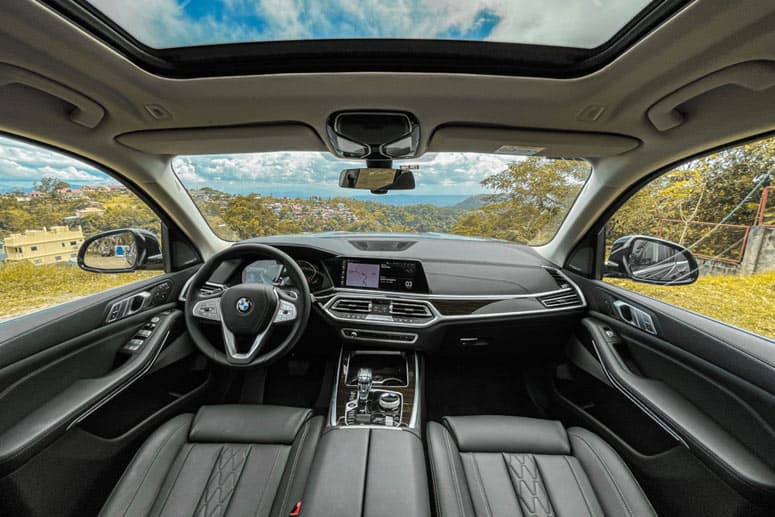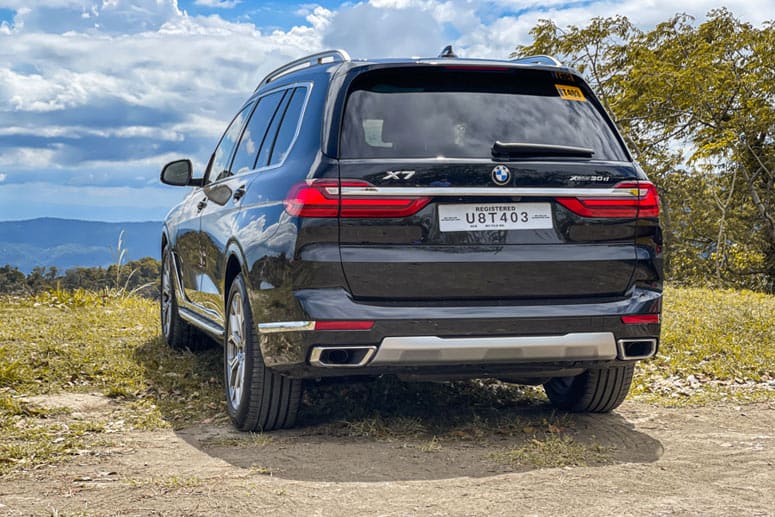Let’s talk about dreams and aspirations. At this point, I believe I’d see myself aspiring for a worry-free future, trying to shield my family from the negativities of the world the best I could. I know, amid the adversities of the pandemic, the idea’s a bit far-fetched. But one can dream, right?
As it turns out, I’d feel that dream and aspiration while driving the BMW SUV combo, the X5 and X7. I’d probably draw flak for that statement but after a quick run toward Tagaytay recently, I couldn’t care less with what financial geniuses would say. I want an X7 for my family, and here’s why.
Visually, both the BMW X5 and X7 sport massive kidney grilles, with the latter bearing a bigger set. Yes, they’re not everyone’s cup of tea, but at least they’re in proportion with the vehicle’s overall size.

The X5 and X7 are the biggest models in the BMW range, but if you need a guide, here’s a quick one—the higher the number, the bigger the size; even numbers for coupes, odd for sedans; M for performance models; and of course, X for SUVs (or Sports Activity Vehicle in BMW-speak).
Looking past the comically large grille, which is by the way adaptive on the X7 (it closes at high speeds), the X5 and X7 are intimidating and authoritative. And that showed during the drive. I couldn’t count how many times vehicles just let me cut into their lanes, like they don’t want to mess with the multi-million luxury SUV. Of course that’s not an excuse to drive precariously, but you get the gist.
It’s the same story at the back. As we wove through the Tagaytay-Santa Rosa road in a convoy, I was staring at the X5’s rear most of the time and believe me, it was a treat. The broad shoulders spell athletic stance, while the way the LED lights glimmer screams premium. We weren’t able to test the X7’s laser headlights since we drove during the day, but we don’t think it’ll be any less posh.

The BMW X5 and X7’s cabin was where my elation rose. The build quality, the way each of the elements connive with each other, everything’s just right. There were many buttons to fiddle with but they aren’t hard to familiarize with. More importantly, the feeling at the driver’s seat was just perfect even at first seating.
The X5 and X7 are similar in layout, but the latter naturally has most of the toys—practically everything BMW could think of adding in their car, except for adaptive cruise control, which isn’t available in the Philippine-spec unit.
One important detail nobody would miss would be the crystal-like gear-shifter of the X7. Another polarizing piece, but one can’t deny that it exudes class. There’s also a certain level of luxury felt with the way the steering wheel and seats open up when you switch off the engine, or the way the infotainment asks you if you would like to save the seat setting that you just applied. Everything’s just intuitive and logical, as it should in a luxurious vehicle.
While the X5 and X7 look similar on the outside (except for the obvious size difference), the main advantage of the X7 is its third-row seats. This is the first time that BMW added the feature on its SUV. It’s not just an “add a third row and you’re good to go” thing—average-sized adults can sit comfortably at the last row. The best thing? Adjustments are done electronically via buttons; there’s even a way to tumble all seats to maximize cargo hold via a single press of a button.
Overall, whether you’re sitting at the front or at the back, the feeling while seated inside both the X5 and X7 is definitely worth the money. It isn’t Rolls-Royce level of opulence, but it’s within the ballpark in terms of feel.
Despite the premium cabin, both SUVs don’t fall short on performance. It’s powered by BMW’s TwinPower Turbo inline-six diesel engine, 263hp and a whopping 620Nm of torque, mated to an eight-speed automatic. Both units have BMW’s xDrive all-wheel drive.
The surge of torque at a slight step on the accelerator tells you that this SUV can deliver power like a performance machine. The pull was almost instant.
The main difference between the X5 and X7, apart from the number of seats, is the addition of air suspension in the latter. The difference was night and day, and in combination with the superb NVH insulation, the ride quality was heavenly, to the point that you’ll feel guilty for not feeling the harshness of the city’s hustle and bustle.
And that’s the clincher here. The BMW X5 is a better driver’s car as it can reflect a good feedback from the ground. It’s more engaging than the X7 and provides a better control on the road. Simply put, I’d rather drive the X5 but I’d rather be sitting at the back and be driven in the X7.
My dreams and aspirations don’t exactly come in a million-peso Bavarian land yacht. It’s peace of mind—it just so happened that that feeling radiated and spoke to me while inside the two-pronged German SUVs named X5 and X7.
As you would have expected, these things don’t come cheap. Priced at P5,990,000 for the BMW X5 and P8,990,000 for the BMW X7. They aren’t exactly affordable by any means, but at least they’re relatively attainable, if not in the immediate future.

